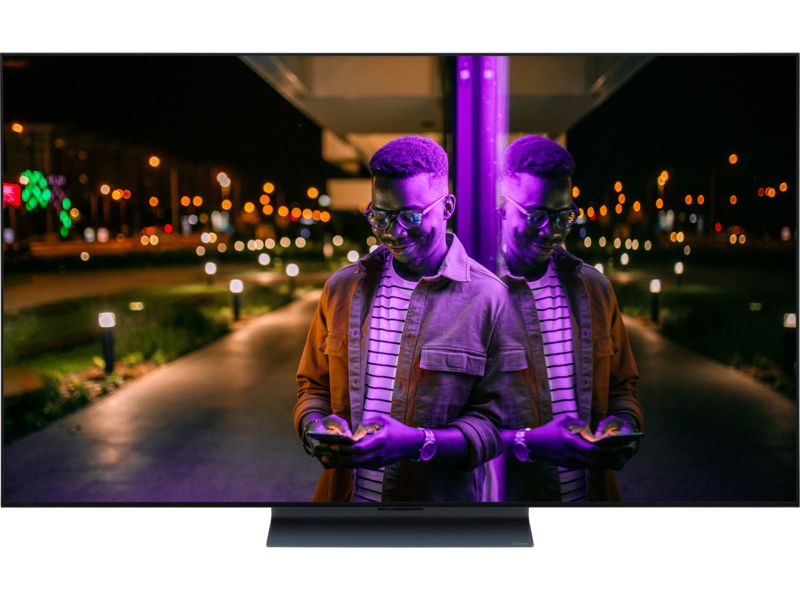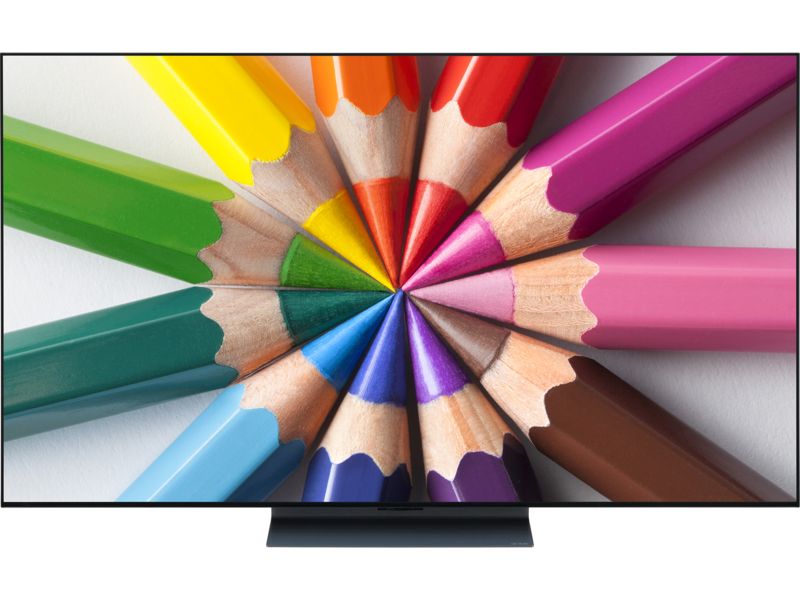TV vs projector: which is best?

Projectors enable you to watch TV and films on an over 100-inch screen at home, and you don't need to win the lottery to buy one.
You do have to put some careful consideration into whether this is the right option compared to a large TV though, projectors do have their limitations. You'll need a dark room or the image on screen can appear washed out and attaching the projector to your ceiling can require extensive DIY.
Are the results worth it, or would you be better off with a wall-mounted TV? We run through the pros and cons of both scenarios to help you decide before you buy.
If you just want to see great TVs, find the right model for you with our expert and independent TV reviews.
Projector pros and cons
Pros:
- Screen size: with the right projector set up, you can be watching a movie as the filmmaker intended, or even super-sizing your PC screen for showing off those holiday photos. Alongside high-definition, you can also buy 3D projectors and 4K projectors (for more, see What is 4K TV?).
- Cost: projectors are, on the whole, cheaper than comparable HD TVs. A 108-inch TV, for example, would cost tens of thousands (if you can find one to buy), but getting the same screen size and equivalent HD picture quality could cost well under a thousand pounds with a projector.
- Viewing experience: many people feel that due to the larger screen size and less overall brightness compared with a TV, projectors can actually give a more comfortable viewing experience. Just as with the cinema, the picture is also typically more immersive.
Cons:
- Light: This is the major drawback with projectors. Unless you have the curtains closed or shades firmly down, a projector’s performance will be affected by any ambient light that comes into the room. Even in a darkened room, any ambient light creeping under the bottom of a drawn curtain can affect the contrast and quality of the image. Opting for blackout blinds or curtains can help stop any extra light getting in.
- Lamps: Projectors have the extra cost of periodically having to replace their lamps, probably once a year.
- Sound: Some projectors have built-in speakers, but realistically with a screen that big you will want to invest in a good home cinema audio set up to do it justice.
"Projectors enable you to watch TV and films on an over 100-inch screen at home, and you won't need to win the lottery to buy one."
Choosing the best projector for you
So you're still keen on a projector? Ok, well let's go through the key information you'll need to choose the right one for you. Front, or video projectors beam images onto a separate screen that can measure well over 100 inches diagonally. You get a convincing cinema-like experience in your home, and you can now buy a decent projector from around £400.
Projectors can be used anywhere there is a power source, a flat surface and enough space. You can either mount them to a ceiling as a permanent installation, or place them on a table or shelf.
You’ll need a big enough room and an empty wall on which to beam the projector image. However, any ambient, or indirect, light that falls on the screen will impact black levels and overall contrast, leading to washed out picture. Ideally, you want as dark a space as possible in which to use a projector, just as with a cinema.

What makes a good projector?
What are lumens? What type of screen should you have? How long do projector bulbs last? Read on to find out all the answers.
- Brightness: brighter is not necessarily better when it comes to buying the best projector. A projector needs to produce enough light to fill a screen, without being so bright that it gets tiring to watch over time. Projector brightness is measured in lumens, and you usually end up paying a premium for a high lumen rating so don’t be dazzled by the numbers. For a projector that will be used in a darkened room, between 1,300 and 1,500 lumens is plenty. You'll only need more if there is more ambient light in your room.
- Screen options: the cheapest option for a projector screen is to use a wall, although the quality of the experience depends on its smoothness, and obviously colour. You can improve this with special reflective paint, but it’s also worth considering a dedicated projector screen. Manual projector screens come in various types, including tripod or wall mounted. There are also motorised projector screens, including premium screens that can be stored away when not in use.
- Connectivity: you can connect lots of different video and image devices to a projector, in the same way you would with an HD TV. Composite or component video handles the standard definition sources, while HDMI sockets are for high-definition video equipment, such as Blu-ray players, games consoles or a Sky box. It’s possible to show photos from memory sticks via the projector’s USB ports, or to hook up a PC or laptop using the VGA monitor sockets. You’ll want to secure and hide any cables if you choose to permanently-install your projector.
Other things to consider
- Throw distance: To get your projector working effectively, you‘ll need to understand the optimum distance between it and the screen, known as the 'throw distance'. This impacts the size of screen you would need and where the projector can be placed. Many projectors have zoom in/out functionality to make minor adjustments to the picture quality without changing the throw distance.
- Projector bulb replacement: You'll know when your projector bulb, or 'lamp', is running out, as the picture will get noticeably dimmer. Lamps can last between 700 and 3,000 hours, with an average life of around 1,500 hours. That might sound like a lot – but with the average Briton watching four hours of TV per day, that’ll give you just over a year of average viewing. A new bulb can cost over £200, which could be a significant annual expense. You can increase the life of lamps by allowing them to cool down properly after use and changing the dust filters regularly. Many projectors have ‘economy modes’ that can also preserve lamp life, and there is often a display showing a rough estimate of how many hours the bulb has remaining.
- Fan noise: As projectors generate heat, they have fans to cool them down. These can be rather noisy on certain models, particularly the cheaper ones. If you think that noise could be an issue for you, go for a model with a quieter fan. It is also important to position your projector so it has enough space and air flow around it to ensure it doesn’t overheat.
Short and ultra-short throw projectors
While conventional projectors need to be set up several metres from your wall in order to create a wide 100-inch image, new innovations mean short and ultra-short throw projectors can be set up much closer to the wall you'll be displaying on.
Short throw projectors need to be around one metre from the wall to display a 100-inch image. Ultra-short throw projectors can achieve the same size image while placed just inches from the wall.
Since they can be placed so close to the wall, these projectors don't need to be ceiling mounted. This means it's easier to connect Blu-ray players and games consoles without needing to feed wires through your walls and ceiling.
These newer types of projector are usually more expensive than the more conventional models, with newly announced ultra-short throw models expected to cost over £10,000.
LCD vs DLP vs LCOS projectors
Just as with conventional TVs, most projectors are either full HD or 4K. Beyond that, there are also three core types of projectors to choose from - LCD, DLP and LCOS - each with its own particular pros and cons.
DLP projectors pros and cons
Pros: DLP projectors give you stunning and realistic pictures on screen. They project a sharper and more detailed image during fast motion sequences compared with other projector types.
Cons: DLP projectors are often larger and nosier. Their bulbs have a relatively short life, meaning they can be costly to maintain. Single-chip DLP projectors are susceptible to the ‘rainbow effect’, a picture flaw involving bright objects on screen appearing to have multi-coloured trails. Not everyone can see these 'rainbows', but it can be very off-putting for those who can. High-end DLP models have three chips - one each for the primary colours – but they're more expensive.
LCD projector pros and cons
Pros: LCD was previously limited to low-quality projectors, but the technology has improved significantly in recent years, and LCD projectors are now comparable with DLP projectors in terms of image quality. LCD projectors are generally cheaper than other models, and more compact. LCD just has the edge over DLP in terms of colour saturation, and it can produce a brighter picture that looks better in ambient light conditions.
Cons: LCD projectors are relatively poor at displaying black areas in the picture. They are also susceptible to the ‘screen door’ effect, where you can see the pixel structure of the LCD, as though you are looking at the picture through a metal screen door. LCD lamps also tend to wear out quickly, but they're cheaper to replace than DLP ones.
LCOS projector pros and cons
Pros: LCOS projectors are generally considered a hybrid of DLP and LCD. They have better resolution, contrast ratios and black levels than the other two projector types.
Cons: LCOS projectors are often not as bright as the other types, and they're usually more expensive, with price tags running to many thousands of pounds.



